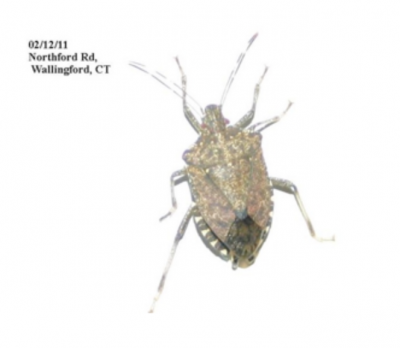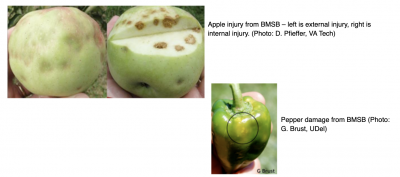Mary Concklin, Visiting Associate Extension Educator, Fruit IPM & Production, UConn
There are at least 20 stink bugs that are considered economically important pests to a variety of crops (not all are in CT, thank goodness) and 6 stinkbugs that are considered beneficial. Of those, the Brown Stinkbug, Euschistus servus, and the Green Stinkbug, Acrosternum hilare, have been around CT for quite some time and have the potential to be economically important pests in some vegetable and fruit crops. The Spined soldier bug, Podisus maculiventris, also a stink bug found throughout the U.S., is a beneficial that feeds on many insects, primarily insect pests of vegetables.

The Brown Marmorated Stink Bug (BMSB), Halyomorpha halys, has been considered a nuisance pest in CT for a few years being found in and on buildings as well as around the edges of agriculture fields. It is now, as of this fall, considered an agricultural pest – no longer just a nuisance – in parts of CT. So why is the BMSB now considered an agricultural pest here and what makes it so worrisome when compared to other stinkbugs? There are a number of reasons: (1) it’s potential to destroy fruit, vegetable and agronomic crops is very real; (2) it has the potential to move into a crop in very high numbers practically over-night, catching growers off-guard; (3) it has a wide host range; (4) the damage from BMSB can be mistaken for other insect injury as well as physiological problems such as boron and calcium deficiencies (see apple and pepper pictures); (5) management with pesticides can undo years of IPM work; and (6) although the use of beneficials and cultural strategies to help manage this pest are rapidly being worked on, we have to be work with what we have now.

The potential to destroy crops was played out in the mid-Atlantic region in 2010 where the apple and peach crops were heavily impacted. For almost 10 years before that it was considered a nuisance pest in homes and buildings. Since 2011, trapping has been done in CT orchards to determine if BMSB is here and where populations are located, to try to avoid the disaster that occurred to our south. Few if any were caught the first couple of years. In 2013 one site had a trap capture of 39 BMSB for one week in a single trap. At that point, an economic threshold had not been established by the USDA. No pesticides were applied and no damage was seen in the field or at harvest. This year the trap captures were very low until late August when one site went from 3 one week to 19 the next week. At that rate I was hoping the crop would be harvested before the numbers gained momentum. Unfortunately, the next week that number jumped to 310 and then to 430. Prior to the week of 310 in a single trap, no eggs, nymphs or adults were seen in the orchard. Now we were finding adults in the trees and early feeding damage from the nymphs was showing up on border trees. An economic threshold was set by the USDA for 2014 at 10/trap or 1 BMSB/100 feet of perimeter orchard row. The potential for the population to blow-up virtually over-night, at a time when most orchardists are busy with harvest and the sprayers have been put away for the season, is going to create management issues. Don’t sit back and think this is only a late season pest – feeding damage has been seen early in the season in other regions.
BMSB has a wide host range of at least 170 identified plants including fruit, vegetable, field crops and ornamentals. With its wide host range, it is impossible to eliminate all of the alternate hosts near crop land. Some crops have been identified as being preferred over others and a few of those are apple, apricot, peach, pear, plum, cherry, pepper, tomato, eggplant, corn, soybean and sunflowers along with many ornamentals. There are many pesticides available to help manage this pest, they will require multiple applications, and some have the potential of disrupting gains in IPM by flaring some pest populations, i.e. mites. The Field Guide to Stink Bugs will help you learn to identify the different stink bugs. It can be accessed on-line at https://pubs.ext.vt.edu/444/444-356/444-356_pdf.pdf. Additional information can be found at http://www.stopbmsb.org/.
The information in this document is for educational purposes only. The recommendations contained are based on the best available knowledge at the time of publication. Any reference to commercial products, trade or brand names is for information only, and no endorsement or approval is intended. UConn Extension does not guarantee or warrant the standard of any product referenced or imply approval of the product to the exclusion of others which also may be available. The University of Connecticut, UConn Extension, College of Agriculture, Health and Natural Resources is an equal opportunity program provider and employer.